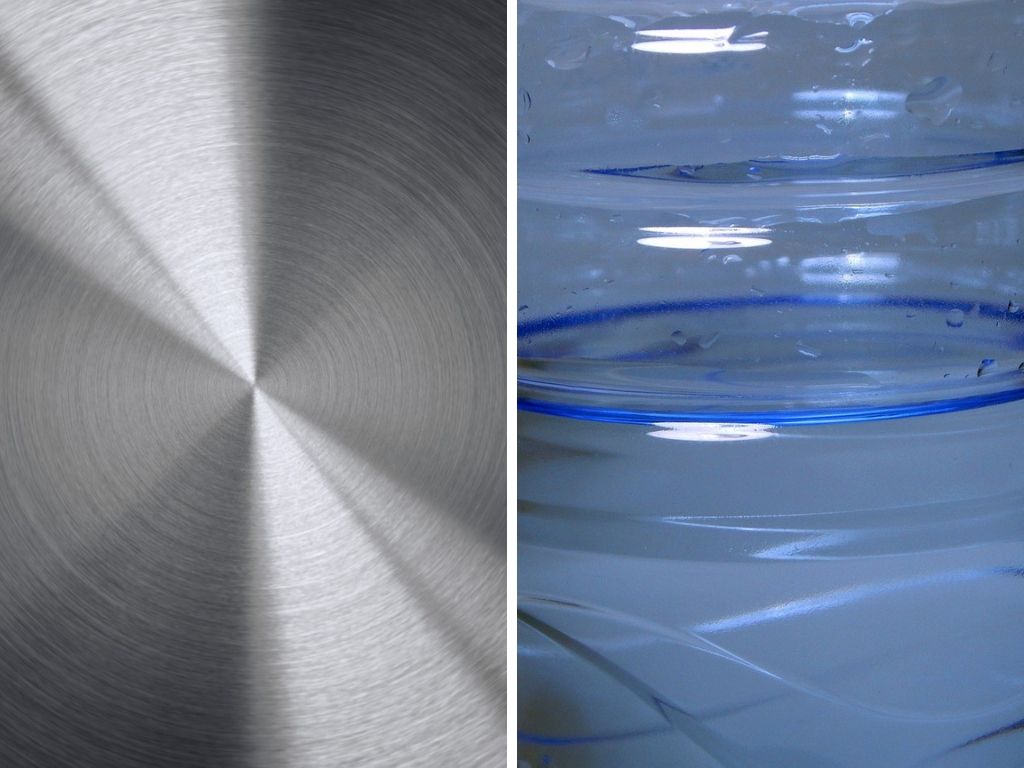In this guide, we outline whether stainless steel is more sustainable than plastic, and vice versa.
This guide compliments our separate guide comparing the sustainability of metals and plastic.
Summary – Is Stainless Steel More Sustainable Than Plastic?
Refer to the linked guide above for a general sustainability assessment of metals like stainless steel vs plastic
However, some sustainability considerations of stainless steel in particular can be found below
Stainless steel can be used in various products, each with their own features and variables, such as their durability, ease of recyclability, and more.
Each product will therefore have a different sustainability footprint.
The sustainability indicator being measured should also be identified and considered, as sustainability ratings can vary for different indicators.
Specifically with drink bottles, a stainless steel bottle that is re-used hundreds of times might be more sustainable in some ways than a single use plastic bottle
Stainless Steel vs Plastic: Comparison
General Sustainability Of Stainless Steel
Across a range of different products, some of the general sustainability considerations might be …
– Stainless steel products generally have a long lifespan and are very durable
They aren’t short use, single use, or highly disposable types of products
– Recyclability of stainless steel
SS is 100% recyclable, and SS is recycled with high recycling rates than some other materials
From bssa.org.uk:
Stainless steel is 100% recyclable …
The main alloying elements of stainless steel (chromium, nickel and molybdenum) are all highly valuable and can be easily be recovered and separated from other materials …
[It’s worth sending stainless steel back to a mill for recycling to cut down on mining and process of ores] (archive.nytimes.com)
– Stainless steel is reasonably circular as new stainless steel products are able to use recycled material
From bssa.org.uk:
Approximately 60% on average of a new stainless steel product is made of recycled material (as an estimate).
This is includes both old scrap and new scrap (along with new raw materials that are added)
– Recycled stainless steel may still use virgin material i.e. it isn’t made entirely of recycled material
From assda.asn.au:
[Stainless steel can be recycled, but may still use new/virgin material in stainless steel products]
Today, stainless steel is made up of approximately 60% recycled content including … 25% reclaimed scrap … 35% industrial scrap … 40% new raw materials
– Micellaneous notes on the general sustainability of stainless steel
The use of SS can also lead to reduction in the use of fossil fuels, improvements in air quality, keeping water clean, the reduction of waste, and other environmental benefits (bssa.org.uk)
Stainless Steel Bottles
From this guide on SS bottles vs bottles made from other materials:
– Recycled iron used in stainless used in stainless steel can reduce the eco impact of stainless steel bottles
– Cold water washing a SS bottle over it’s lifetime may be more eco friendly than hot water washing in a dishwasher for example
– Re-using a SS bottle 500 times may mean that bottle beats a plastic bottle across many environmental indicators
– SS bottles may have leaching issues though if made with aluminum, or if they aren’t lead free food grade SS material.
– Some SS bottles also include plastic liners inside
Stainless Steel vs Plastic
– Sourcing of materials
… SS uses iron ore, chromium and nickel – which all have to be mined, and processed, and metals extracted from the ore
Plastic on the other hand comes from mainly non renewable petrochemicals and other additives
Some may question whether we will run out of fossil fuels like oil or natural gas (used as a feedstock for plastic) anytime soon.
– Production of stainless steel
Production of SS can be energy intensive like other metal production is
The production of SS can use more fossil fuels, release more GHGs, and demand the extraction of more metal resources compared to plastic bottles. There may also be air, water and soil pollution involved.
Recycled iron in stainless steel can result in a more environmentally production process.
… the process that converts iron ore into stainless steel (where the steel is alloyed with chromium to prevent corrosion and create a shiny finish) is energy intensive (greenlifestylemag.com.au)
…producing stainless steel results in about 10 times more pollution than regular steel … [but using recycled iron can reduce environmental impact] (archive.nytimes.com)
– Stainless steel may not cause the pollution or leaching issues that plastic might as waste
Stainless steel doesn’t leach into the soil or if it becomes pollution in the environment, and doesn’t break down into micro-plastics
– Both stainless steel and plastic waste may not be highly damaging in landfills
Plastic doesn’t emit methane like organic waste does in landfills when it breaks down, and stainless steel is the same
bssa.org.uk also mentions: ‘Stainless steel rarely has damaging effects in a landfill’
Having said that, in landfills with poor leachate management and ineffective liners, some plastics like PVC may be problematic or toxic in some instances
The Sustainability Of Plastic
Read more specifically about the sustainability of plastic in this guide.
This guide also outlines some of the overall pros and cons of plastic.
Other Factors To Consider
– Just as there are different types of plastic, there are different types of stainless steel.
Each different type of stainless steel can have a different sustainability footprint
– The waste management systems, facilities and technology in a given country or State make a difference to the sustainability not just of different materials, but different waste items and products (because of how different waste materials and items are processed among the different disposal options at different rates)
– How long a stainless steel product or item lasts, or how many times it can be used/re-used before being thrown out, impacts it’s sustainability footprint
– Whether the stainless steel is recycled material can also make a difference to sustainability
Sources
1. https://www.bettermeetsreality.com/plastic-vs-glass-vs-metal-stainless-steel-aluminum-bottles-comparison-which-is-best/
2. https://www.bssa.org.uk/sectors.php?id=99#recycling
3. https://www.assda.asn.au/technical-info/environment-health-and-safety/recycling
4. https://archive.nytimes.com/www.nytimes.com/interactive/2009/04/19/opinion/20090419bottle.html?_r=0
5. https://www.greenlifestylemag.com.au/features/2436/plastic-vs-stainless-steel-vs-aluminium-reusable-water-bottles?page=0%2C0
','' ); } ?>